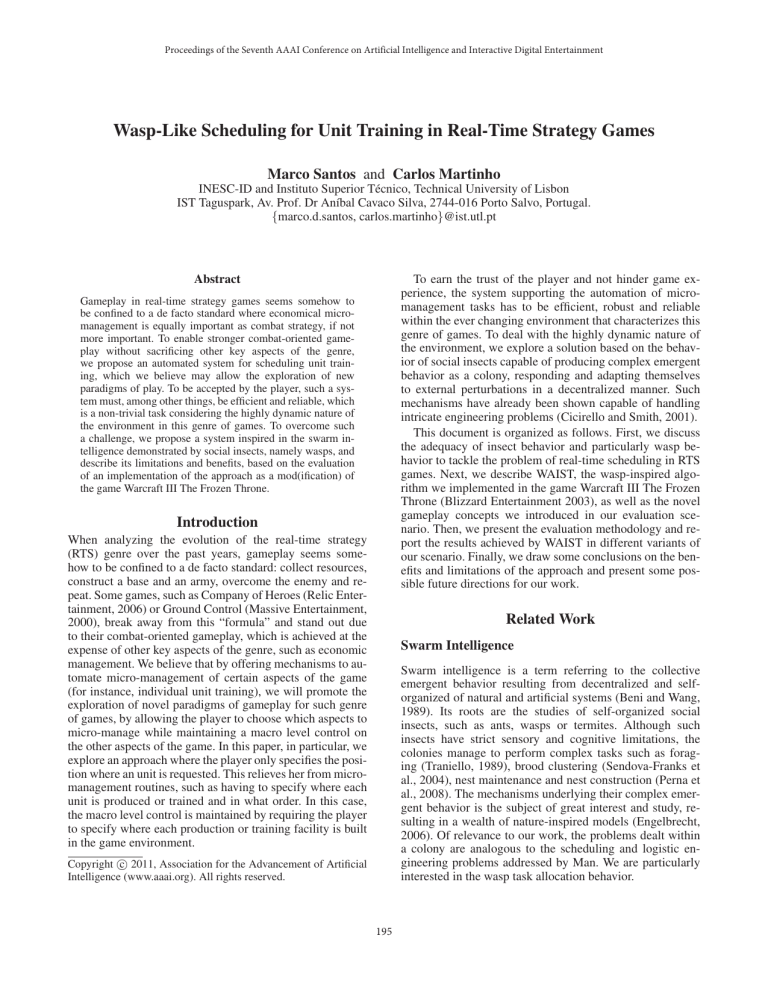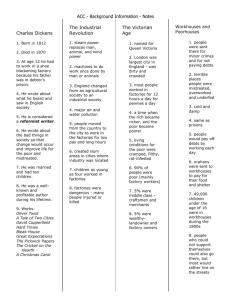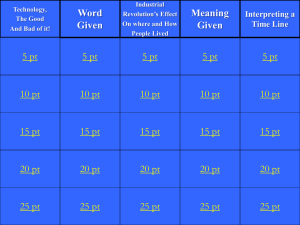
Proceedings of the Seventh AAAI Conference on Artificial Intelligence and Interactive Digital Entertainment
Wasp-Like Scheduling for Unit Training in Real-Time Strategy Games
Marco Santos and Carlos Martinho
INESC-ID and Instituto Superior Técnico, Technical University of Lisbon
IST Taguspark, Av. Prof. Dr Anı́bal Cavaco Silva, 2744-016 Porto Salvo, Portugal.
{marco.d.santos, carlos.martinho}@ist.utl.pt
To earn the trust of the player and not hinder game experience, the system supporting the automation of micromanagement tasks has to be efficient, robust and reliable
within the ever changing environment that characterizes this
genre of games. To deal with the highly dynamic nature of
the environment, we explore a solution based on the behavior of social insects capable of producing complex emergent
behavior as a colony, responding and adapting themselves
to external perturbations in a decentralized manner. Such
mechanisms have already been shown capable of handling
intricate engineering problems (Cicirello and Smith, 2001).
This document is organized as follows. First, we discuss
the adequacy of insect behavior and particularly wasp behavior to tackle the problem of real-time scheduling in RTS
games. Next, we describe WAIST, the wasp-inspired algorithm we implemented in the game Warcraft III The Frozen
Throne (Blizzard Entertainment 2003), as well as the novel
gameplay concepts we introduced in our evaluation scenario. Then, we present the evaluation methodology and report the results achieved by WAIST in different variants of
our scenario. Finally, we draw some conclusions on the benefits and limitations of the approach and present some possible future directions for our work.
Abstract
Gameplay in real-time strategy games seems somehow to
be confined to a de facto standard where economical micromanagement is equally important as combat strategy, if not
more important. To enable stronger combat-oriented gameplay without sacrificing other key aspects of the genre,
we propose an automated system for scheduling unit training, which we believe may allow the exploration of new
paradigms of play. To be accepted by the player, such a system must, among other things, be efficient and reliable, which
is a non-trivial task considering the highly dynamic nature of
the environment in this genre of games. To overcome such
a challenge, we propose a system inspired in the swarm intelligence demonstrated by social insects, namely wasps, and
describe its limitations and benefits, based on the evaluation
of an implementation of the approach as a mod(ification) of
the game Warcraft III The Frozen Throne.
Introduction
When analyzing the evolution of the real-time strategy
(RTS) genre over the past years, gameplay seems somehow to be confined to a de facto standard: collect resources,
construct a base and an army, overcome the enemy and repeat. Some games, such as Company of Heroes (Relic Entertainment, 2006) or Ground Control (Massive Entertainment,
2000), break away from this “formula” and stand out due
to their combat-oriented gameplay, which is achieved at the
expense of other key aspects of the genre, such as economic
management. We believe that by offering mechanisms to automate micro-management of certain aspects of the game
(for instance, individual unit training), we will promote the
exploration of novel paradigms of gameplay for such genre
of games, by allowing the player to choose which aspects to
micro-manage while maintaining a macro level control on
the other aspects of the game. In this paper, in particular, we
explore an approach where the player only specifies the position where an unit is requested. This relieves her from micromanagement routines, such as having to specify where each
unit is produced or trained and in what order. In this case,
the macro level control is maintained by requiring the player
to specify where each production or training facility is built
in the game environment.
Related Work
Swarm Intelligence
Swarm intelligence is a term referring to the collective
emergent behavior resulting from decentralized and selforganized of natural and artificial systems (Beni and Wang,
1989). Its roots are the studies of self-organized social
insects, such as ants, wasps or termites. Although such
insects have strict sensory and cognitive limitations, the
colonies manage to perform complex tasks such as foraging (Traniello, 1989), brood clustering (Sendova-Franks et
al., 2004), nest maintenance and nest construction (Perna et
al., 2008). The mechanisms underlying their complex emergent behavior is the subject of great interest and study, resulting in a wealth of nature-inspired models (Engelbrecht,
2006). Of relevance to our work, the problems dealt within
a colony are analogous to the scheduling and logistic engineering problems addressed by Man. We are particularly
interested in the wasp task allocation behavior.
c 2011, Association for the Advancement of Artificial
Copyright Intelligence (www.aaai.org). All rights reserved.
195
Task Allocation of Wasps
them the ability to bid for the tasks most suited for them,
while allowing them to do other tasks if needed. Second,
force permits a fair distribution of the workload between the
agents by taking into consideration their characteristics for
the task when determining the winner. These two aspects,
together, allow the system to self-regulate and dynamically
respond to unexpected events like variations in demand.
Such characteristics are relevant for real-time scheduling
in the RTS game genre. As such, in this work, we extended
and adapted the R-Wasp algorithm to the RTS game domain
and evaluated its adequacy.
From their studies of the polistes dominulus wasps, Theraulaz et al. (1991) created a model of dynamic task allocation that emulates the self-organized behavior of wasps. The
system has the following main features:
• Tasks have the capacity of emitting stimuli that affect the
individuals’ task selection decisions;
• Individuals possess response thresholds that represent
their predisposition to perform certain tasks;
• Each individual has a force that is taken into account during dominance contests to determine the winner;
• When an individual performs a certain task, its response
threshold changes to increase the predisposition to repeat
the task, creating specialists in the society.
These four features drive the model both toward performance and flexibility. The system self-organizes itself towards optimal performance due the individuals’ capacity of
specialization. This specialization, however, is not rigid, allowing them to dynamically adapt their work force according to the constantly changing environment (e.g. loss of individuals). Such characteristics are of importance when considering the needs of real-time scheduling for RTS games.
Scenario
Before detailing our adaptation of R-Wasp to RTS games,
we will first describe the evaluation scenario. We implemented a modification (mod) of the video game Warcraft III
The Frozen Throne (Blizzard Entertainment, 2003) providing the player with a new type of interface to request units.
In the base game, to build a new unit, the player has first to
build a “unit factory” and then issue build orders individually for each unit. Each type of factory is only able to produce a limited number of units and unit types, and different
factories produce different unit types. As such, the player
has to micro-manage unit production and constantly move
between factories, while controlling all the other aspects of
the game simultaneously.
Our scenario provides the player with a macro-level management of unit production and explores a new paradigm
of gameplay. The player still decides which factory types to
build and where to build them but, afterwards, only needs
to specify the location where a certain amount of units of
certain types are requested, and the underlying system will
devise a near-optimal production schedule accordingly. As
such, we ensure there are still meaningful choices for the
player to make regarding resource management, albeit at a
completely different level.
Since scheduling is automated and does not hinder cognitively the player, we provided additional interesting choices,
by refining the production model and introducing unit heterogeneity in factory production, i.e. different factories are
able to produce the same unit type but have different production times, and an extra setup time is required when production changes from one type of unit to another.
Specifically, in our evaluation scenario (see Fig. 1):
Routing-Wasp
Based on the properties of the natural model created by
Theraulaz et al. (1991), Cicirello and Smith (2001) proposed an algorithm for dynamic task allocation that later was
adapted to Morley’s factory problem from General Motors
(Morley, 1996), denominated Routing-Wasp or R-Wasp.
In this algorithm, each different task is capable of emitting
stimuli which strength if proportional to the time the task
has remained unassigned: the longer a task remains unassigned, the stronger the emitted signal. Each agent has a response threshold associated with the tasks it is capable of
performing, representing its propensity to bid for the task:
the lower the threshold, the higher the propensity to bid. For
each unassigned task, agents stochastically decide to bid or
not according to the strength of the emitted stimulus and the
response threshold associated to the task.
After all the agents have decided to bid or not, and if there
is more than one candidate, a dominance contest occurs. The
dominance contest consists in a tournament where duels are
made until one last standing agent wins. The winner of a
duel is stochastically settled taking into consideration the
agent forces, which vary according to their suitability to perform the task. The task is then assigned to the dominance
contest winner.
Finally, response thresholds are updated. The more an
agent performs tasks of a certain type, the more the threshold decreases and the more likely it will accept other tasks
of the same type. Reversely, the less an agent performs a certain type of tasks to the detriment of others, the less likely it
will accept tasks of that type. Additionally, if an agent is not
performing any task, all thresholds are gradually lowered,
increasing the propensity to accept any task.
The R-Wasp strength lies in two aspects. First, response
thresholds allow the creation of task specialists and gives
• Only two types of units are considered: F (ootman) and
R(ifleman);
• Changing from the production of one type of unit to another results in extra setup time before resuming production;
• Five different factories are available to the player (see Fig.
1), each one with different balanced properties:
– Two specialized factories (FF and FR ) are efficient at
producing one type of unit (F and R respectively) but
unable to produce the other.
– One factory (FH ) is able to produce both unit types
but not as efficiently as the specialized factories. Setup
time, however, is very high.
196
– Two other factories (FF R and FRF ) are also able to
produce both unit types and have a lower setup time
than the hybrid factory. However, one of the unit type
has a high production time.
If no factory bids for the task, the task remains unassigned
until the next cycle. If only one factory bids for the task, it is
attributed to it. If more than one factory bids for the task, the
winner is selected after a tournament of dominance contests.
First, if an odd number or factories bid, the number of participants is made even: N factories are automatically passed
to the next phase of the tournament according to Eq. 2, in
which C stands for the number of competitors.
N = 2log2 (C) − C
Each dominance contest takes the resistance of the biding
“wasp factories” into consideration. The probability of factory f1 winning over factory f2 in a duel is given by Eq. 3, in
which Rf1 and Rf2 represent the resistance of each factory
respectively.
Figure 1: Representation of the scenario factories. As an example, FF R can produce F and R but R will take more
time. If after producing a F (ootman) the player orders a
R(ifleman), a medium setup time is required before the production of R begins.
P (f1 wins | Rf1 , Rf2 ) =
WAIST Model
We will now describe the algorithm used to implement realtime scheduling in our scenario. The pseudocode for the algorithm is depicted in Fig. 2.
var: list of unassigned orders
var: list of factories
var: list of candidates = {}
for-each unassigned order
for-each factory
decide to bid or not
if( bid )
candidates <- factory
dominance contest between candidates
assign order to the winner
update forces
update thresholds
update stimuli
Rf = Tprd + Tstp + Tdlv
(3)
(4)
In each cycle, all response thresholds of each factory are
updated according to the following function:
⎧
Tf,t − δ1
⎪
⎪
⎪
⎪
⎪
⎪
⎨ Tf,t + δ2
if the last task in factory f queue
is of type t
if the last task in factory f queue
is not of type t
Tf,t =
⎪
⎪
if factory f queue is idle
Tf,t − δ3
⎪
⎪
⎪
⎪
−
δ
if factory f queue is idle and there
T
4
⎩ f,t
is an unassigned task of type t
(5)
δ1 acts as a “learning” coefficient, since it diminishes the
threshold and encourages the factory to take tasks of the
same type, as opposed to δ2 , which acts as an “unlearning”
coefficient. These two rules are important to increase the sequencing of orders in the factories’ queues and, as a result,
reduce the number of setups. When factories are idle, their
response thresholds are slowly decreased by δ3 if there are
no unassigned tasks, and more rapidly decreased by δ4 > δ3
to ensure factories do not remain inactive if there are still
tasks to perform. Thresholds are also clamped to a maximum range.
Task stimuli are also updated every cycle, according to
Eq. 6, to ensure that a task does not remain unassigned indefinitely.
(1)
(2,3)
(4)
(5)
(6)
Figure 2: Pseudo-code of the algorithm. The marked steps
are detailed in the main text.
Each unit requested by the player is a task that must be
performed. Tasks have a type, which is defined by the type
of the unit to be produced (in our scenario, Footman or Rifleman), and are capable of emitting stimuli perceptible by
all existing factories.
Each factory f capable of producing units of a certain type
is conceptually modelled as a wasp capable of executing
production tasks and has a response threshold Tf,t associated with this task t. When a factory f receives a stimulus
St from a task t, it stochastically decides to bid or not to bid
according to the probability defined by Eq. 1.
S2
P (bid | Tf,t , St ) = 2 t 2
St + Tf,t
Rf22
Rf21 + Rf22
The resistance Rf of a factory f is given by Eq. 4, where
Tprd is the sum of all the production times of the tasks currently in the factory’s queue, the task being processed and
also the one being disputed; Tstp is the sum of all required
setups, considering the task being disputed; and Tdlv is the
estimated time the unit will need to reach its target from the
factory (i.e. to be “delivered”). The lower the resistance, the
faster the factory will execute the task.
This scenario will by used to test the system’s response to
a series of unit requests using a preset of factories.
1
2
3
4
5
6
7
8
9
10
11
12
13
(2)
St = St + δ S
(6)
This update rule ensures that older requests have higher
priorities since they will emit stronger stimuli, but also allow
(1)
197
more specialized factories to bid for other types of tasks if
necessary. As a note, different factors could be easily added
to Eq. 6 to create other priority criteria instead of “unassigned time” (e.g. “unit priority”).
this algorithm takes into account the global state of the
whole game at the time of the decision.
For evaluation purposes, the following data was gathered
during each run:
Unassigned time: the time interval between the moment a
unit is requested and the moment it is assigned to a specific factory (unsgnd);
Evaluation
The evaluation of our scenario consisted in running automated scripts that, at certain time intervals, requested one or
more units at certain points of the map, simulating a typical
human player input. To execute the orders, 3 factories were
positioned close to each other, simulating a “base camp”.
The type of the factories was chosen randomly, with the
constraint that the production of both Footman and Rifleman
units should be possible within this base camp. Each run was
evaluated with 5 different base camp configurations.
To evaluate our approach, five different variants of our
base scenario were implemented and tested within the Warcraft III game environment, ensuring that factors such as
pathfinding, collisions between units and with the environment, were accounted for in the in-game simulation:
Queued time: the time interval between the moment a request is assigned to a factory and the moment the factory
starts its production (queued);
Training time: the time spent by the factory to produce the
unit (traing);
Delivery time: the time a unit, after been produced, takes
to reach the designated target rally point (delvry);
Number of setups: the total number of setups during the
whole scenario (setups);
Execution time: the total scenario duration, that is, until
the last unit reaches its target rally point (test).
Even (unit distribution): at regular time intervals, a new
request is issued. The requested unit has 50% chance of
being either a Footman or a Rifleman.
The “closest” and “global” algorithms are deterministic and
were executed 3 times for each script, to account for the
stochastic nature of the game environment. Both “random”
and WAIST are intrinsically stochastic, and as such were executed 15 times for each scenario. In both cases, the final
result is the average of all runs.
Our approach requires setting a considerable amount of
parameters. To specify and tune this set of parameters, we
performed several iterations of smaller (and faster) runs consisting of 40 unit requests over the base scenario. After the
parameters were defined, we performed the final tests which
included 100 requests for each one of the five scenario variants and each one of the four algorithms, each run being
evaluated with the five base camp configurations.
Uneven (unit distribution): a new request is issued at regular time intervals. With 90% chance, the requested unit
is a Footman, otherwise it is a Rifleman. When half of the
units have been requested, the distribution is mirrored, i.e.
there is 10% chance of the request being a Footman and
90% chance of being a Rifleman.
Destruct (and construct): in this variant, during the course
of the scenario, two factories are destroyed and, afterwards, two random others (under the same constraints)
are constructed.
Burst: instead of being ordered regularly, units are requested in bursts, i.e. in small time intervals, with longer
pauses between bursts.
Results
“Even” Scenario
More (factories): the number of available factories is increased to 9 in this variant, grouped into 3 base camps of
3 factories, and spread out throughout the map.
Fig. 3 shows the results for the “even” scenario. In this scenario, WAIST marginally outperformed “global”. Although
WAIST takes longer to assign requests, this delays pays
off since it significantly reduces the number of setups required (in this case, by 75%). Without response thresholds
or the capacity to anticipate future requests, “global” execution time is penalized by the delays introduced by the setups. “Closest” was unable to share the workload between
the different factories, since request assignment is exclusively based on distance. The lower “delivery” time did not
compensate for this feature and set “closest” near the performance of “random”.
To evaluate the performance of our approach, we ran each
scenario variant using three additional algorithms:
Random: this algorithm randomly selects one of the available factories capable of producing the requested unit and
having free slots in its production queue. This scenario
serves primarily the purpose of creating a baseline.
Closest: this algorithm attributes production requests to the
closest factory with empty slots in its queue. This algorithm simulates the assignment strategy commonly used
by “newcomer” players.
Random
Closest
Global
WAIST
Global: this algorithm attributes production requests to the
expected fastest factory, taking into consideration the time
needed for the requested unit to move from the factory to
the target rally point in a straight line, and all production
and setup times of the requests in its queue, plus the one
being disputed. While not ensuring optimal performance,
Unsgnd
19.94
16.15
4.38
9.49
Queued
87.85
91.01
75.45
69.14
Traing
21.80
20.73
20.14
19.83
Delvry
8.75
8.07
8.60
8.55
Σ
138.36
135.98
108.58
107.02
Test
697.60
695.66
663.66
661.93
Figure 3: Results for the “even” scenario.
198
Setups
16.73
15.33
13.33
3.40
“Uneven” Scenario
while ahead of both “random” and “closest”. Unexpectedly,
WAIST did use approximately the same number of setups as
“global”. A possible explanation for this fact is that, as more
factories are available, idle periods are longer and several
factories may experience a premature loss of specialization.
As in the previous scenario, the rate at which the response
threshold decreases may not be the more adequate for such
scenario and fine tuning the related parameters may provide
better results.
Fig. 4 shows the results for the “uneven” scenario. In this
scenario, “global” yielded better results. Because of the peculiar distribution of the request for both types of units, the
number of setups for “global” was lower, and WAIST required a certain period of adaptation for the factories to
loose their specialization, which in this case penalized the
approach. Still, WAIST performed above both “random” and
“closest” in this scenario, and only 1.5% below “global”.
Random
Closest
Global
WAIST
Unsgnd
23.06
22.35
15.09
20.03
Queued
81.75
80.33
69.06
71.43
Traing
20.78
20.28
20.11
20.07
Delvry
9.55
8.69
9.36
9.31
Σ
135.16
131.66
113.63
120.86
Test
833.06
820.00
782.66
794.60
Setups
10.00
6.33
6.00
2.93
Random
Closest
Global
WAIST
Fig. 5 shows the results for the “destruct” scenario. In this
scenario which included the destruction and construction of
new factories while requests were issued, WAIST showed its
robustness by achieving the best performance. Results suggest the reduced number of setups to be one of the main
explanation for the fact. Peculiarly, “closest” had the highest “delivery” time in this scenario, due to the unexpected
destruction of the factories closest to the rally point at the
time of request assignment.
Queued
92.62
87.09
76.27
75.33
Traing
21.68
21.32
20.50
20.32
Delvry
9.82
9.92
9.27
9.26
Σ
145.42
135.81
113.96
116.08
Test
729.20
712.00
684.86
676.66
Traing
22.13
22.42
20.12
21.01
Delvry
13.15
5.45
7.37
12.46
Σ
48.81
84.23
30.43
37.60
Test
545.86
615.66
492.66
507.66
Setups
28.26
27.66
15.66
16.06
An important remark is that, due to the high number of
available factories in comparison to the request rate, “random”, “closest” and “global” assigned production tasks to
factories without delay. This could be an indication that
WAIST is more indicated when congestion is experienced,
although its performance, while not optimum, is acceptable
in less congested situations.
“Destruct” Scenario
Unsgnd
21.27
17.47
7.90
11.15
Queued
12.53
55.34
1.92
3.08
Figure 7: Results for the “more” scenario.
Figure 4: Results for the “uneven” scenario.
Random
Closest
Global
WAIST
Unsgnd
1.00
1.00
1.00
1.04
WAIST Overall Performance
Fig. 8 compares the total execution time for each algorithm across the five different scenario variants used during
the evaluation phase. Both WAIST and “global” algorithms
achieved a similar performance, “global” only outperforming WAIST by an average of 0.9% over the five scenarios.
Setups
22.00
23.06
19.06
2.86
Figure 5: Results for the “destruct” scenario.
“Burst” Scenario
Fig. 6 shows the results for the “burst” scenario. In this
scenario, in which units were requested by bursts rather
than uniformly over time, “global” achieved the best performance, while both WAIST and “closest” shared a similar
performance. This scenario demonstrated a possible weakness in the WAIST approach. Although this result could be
related to the non-optimal tuning of δ3 and δ4 , that control how fast a factory looses its specialization when idle,
WAIST was unable to distribute work efficiently during the
in-between-burst time intervals.
Random
Closest
Global
WAIST
Unsgnd
49.18
47.24
40.50
46.95
Queued
106.92
103.61
102.76
103.75
Traing
20.72
20.58
20.42
20.50
Delvry
13.16
8.51
8.80
8.86
Σ
189.99
179.96
172.50
180.07
Test
691.26
679.33
663.00
678.20
Figure 8: Overall results of the evaluation phase.
Setups
13.33
12.33
10.66
9.00
We consider this an encouraging result for WAIST, taking into consideration that scheduling relies only on local
information, while “global” has access to all information at
once. In comparison to “global”, WAIST presented the additional advantage of allowing factories to wait for best suited
requests by using the response threshold mechanism.
In this work, WAIST parameters were tuned by hand. We
believe the use of an optimization algorithm could provide
a better set of parameters, especially when the specific characteristic of the scenario are known beforehand, although
Figure 6: Results for the “burst” scenario.
“More” Scenario
Fig. 7 shows the results for the “more” factories scenario.
In this scenario, “global” outperformed WAIST by only 3%,
199
its use would require a considerable amount of time when
considering the simulation running in an environment such
as the Warcraft III game engine. In future work, we intend
to research whether the performance of WAIST would further increase using optimal tuning of the parameters for each
specific scenario variant.
compared WAIST performance in each of the five scenarios to three other approaches: random attribution; distancebased attribution, and global attribution which considers all
the information available in the game environment.
Overall, WAIST performed comparably to the global attribution algorithm (and better than the other two), an encouraging result considering WAIST is a decentralized algorithm that relies on local information while the latter has
full global knowledge. As such, we believe WAIST to be
an efficient and reliable alternative for real time scheduling in real time strategy games. While WAIST experiences
some limitations when dealing with low amounts of requests, it demonstrated good performance in situation of
higher congestion of requests, and when setting up from
one production to another is expensive. The limitations observed in these situations could be related to fine tuning
specialization-related parameters for the specificities of each
scenario, and should be researched further. Due to its decentralized and multi-agent nature, WAIST should also be able
to scale relatively well performance-wise, and take advantage of multi-core processors.
WAIST Benefits
Although not the most efficient approach in all possible situations, WAIST demonstrated to be an efficient and versatile approach for unit production scheduling in RTS games,
even when compared to a centralized algorithm. WAIST was
found to be most appropriate in games with the following
characteristics:
• Significant setup times: in this work, setups accounted for
approximately 10% of the time needed to train or produce
a unit. We expect higher setup times to boost WAIST performance in comparison to the other approaches;
• Congestion of requests: WAIST is most suited for situation with continuous high request rate, which is expected
at higher levels of play. Due to the lack of idle times, specialization ensures the adequacy of the algorithm;
References
• Performance scalability: WAIST is adequate for larger
scale scenarios. While the production queue and the capability of all factories are evaluated to select the best
possible choice in a centralized solution, bidding and
dominance contests require less computation power while
achieving a similar performance.
Beni, G., and Wang, J. 1989. Swarm intelligence in cellular robotic systems. In Proc. NATO Advanced Workshop on
Robots and Biological Systems, 26–30.
Cicirello, V., and Smith, S. F. 2001. Wasp nests for selfconfigurable factories. In Müller, J. P.; Andre, E.; Sen, S.;
and Frasson, C., eds., Proceedings of the Fifth International
Conference on Autonomous Agents, 473–480. ACM Press.
Engelbrecht, A. 2006. Fundamentals of Computational
Swarm Intelligence. Wiley.
Another benefit comes from its agent-based nature. In this
work, due to the use of the Warcraft III World Editor, the
algorithm is executed sequentially. However, this algorithm
can take advantage of the parallel computation offered by
multi-core processors and multi-agent systems, increasing
its computational efficiency even further.
Morley, D. 1996. Painting trucks at general motors: The
effectiveness of a complexity-based approach. Embracing
Complexity: Exploring the Application of Complex Adaptive
Systems to Business, The Ernst and Young Center for Business Innovation 53–58.
Perna, A.; Jost, C.; Valverde, S.; Gautrais, J.; Theraulaz, G.;
and Kuntz, P. 2008. The topological fortress of termites. In
Bio-Inspired Computing and Communication, 165–173.
Conclusion
In this paper, we presented a new paradigm for scheduling
unit production and training in real-time strategy games, inspired by the social behaviour of wasps which, using only local knowledge and cues, are able to efficiently allocate tasks
while adapting themselves to the inconstant colony needs
and frequent environment changes. We adapted the R-Wasp
algorithm, a wasp-based task allocation algorithm applied to
certain engineering problems, to the real-time scheduling of
units in a real-time strategy game, and described WAIST, a
first step toward the exploration of new paradigms of gameplay for real-time strategy games relying on the support of
player-friendly artificial intelligence.
We described a series of five scenarios with which we
evaluated WAIST under different situations within the game
environment of the game Warcraft III. The scenarios introduced a new feature observable in real factories to the current language of game mechanics related to real-time strategy games: heterogeneity i.e. “factories” with different characteristics, and extra production costs, either of resources or
time, resultant from the change of production. To get a better idea of the benefits and limitations of the approach, we
Sendova-Franks, A.; Scholes, S.; Franks, N.; and Melhuish,
C. 2004. Brood sorting by ants: two phases and differential
diffusion. Animal Behaviour 68.
Theraulaz, G.; Goss, S.; Gervet, J.; and Deneubourg, J.-L.
1991. Task differentiation in polistes wasp colonies: a model
for self-organizing groups of robots. In From Animals to
Animats: Proceedings of the First International Conference
on Simulation of Adaptive Behavior, 346–355.
Traniello, J. F. A. 1989. Foraging strategies of ants. Annual
Review of Entomology 34:191–210.
200




